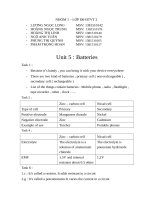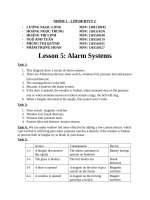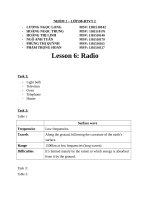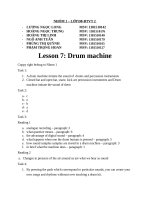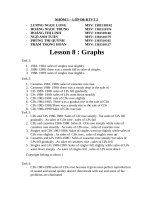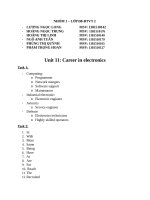Điện tử viễn thông DTVT2 nhom4 bai3 khotailieu
Bạn đang xem bản rút gọn của tài liệu. Xem và tải ngay bản đầy đủ của tài liệu tại đây (157.48 KB, 11 trang )
Batteries
D8-DTVT2
Group 4:
Ngô Đắc Quân
Lê Văn Hoạch
Phùng Thế Quảng
Phạm Thị Minh Phượng
Nguyễn Thị Phương
Ngô Thị Phượng
Nguyễn Nhật Thư
Nguyễn Tuấn Anh
Turning in
Task 1: Study this statement:
Twenty billion batteries are sold every year.
Why do you think this is so? What different kinds of batteries are there?
-
-
Because batteries have a lot of electronic, although it’s very small. Batteries
can bring everywhere and use for a long time. So it’s areason why many
people buy and use batteries.
It has some kind of batteries in real life include: zinc- cacbon battery,
alkaline battery, lithium- ion battery, lead- acid battery…
List some of the things you use which contain batteries. Compare your list
with someone else’s
-
Control television
Control pan
Coputer
Smart phone
Camera
Task 2: Try to complete this table of the differences between two
kinds of cells. Use these terns:
Type of cell
Positive electrode
Negative electrode
Example of use
Zinc-Carbon cell
Primary
Manganese dioxide
Zinc
Torches
Nicad cell
Secondary
Nickel
Cadmium
Portable phones
Task 3: Now listen to the tape to check your answers.
Task 4: Now read this text. Note any further information about
these cells.
Zinc- carbon cell
It has a zinc negative electrode, a manganese dioxide positive electrode, and the
electrolyte is a solution of ammonium chloride. The carbon rod is in contact with
the positive electrode(but is not involved in the chemical reaction) and is called the
current collector. The EMF is 1.5V and the internal resistance about 0.5Ω. This is
the most popular cell for low- current or occasional use, e.g. in torches.
Nickel-cadmium cell (NiCad)
The electrodes are of nickel (+) and cadmium (-) and the electrolyte is potassium
hydroxide. It has an EMF of 1.2V and is made in the same sizes as primary cells,
e.g. HP2, PP3; button types are also avaiable. High currents can be supplied.
Recharging must be by a constant current power supply because of the very low
internal resistance
Electrolyte
EMF
Zinc- Carbon cell
CH3Cl
1.5V
Nicad cell
KOH
1.2V
Task 5: Label this diagram of a Zinc- carbon cell with these terms.
More than one term can refer to the same part of the diagram.
Language study Describing components
1: What is it called ?
2: What does it do ?
Answer:
1 : label components.
2: describe their function.
It is called Zinc- cacbon cell . it provide electricity ( cells change chemical
energy into ecletric energy)
It is current collector . it is function lead in batteries.
Task 6: Here are some circuit symbols. Label them and describe their function.
1.It is called a resistor. It adds resistance to a circuit.
2.It is called variable resistor. Its varies the current in a circuit.
3.It is called a transformer. It steps AC voltages up to down.
4.It is a switch. It breaks a circuit.
5.It is a diode. It rectifiles alternating current.
6.It is a voltmeter. It measure voltages.
7 .It is a variable capacitor. It varies capacitance in a circuit.
8. It is a fuse. It protecs a circuit.
9. It is a mili ammeter. It measures very small currents.
10. It ia a anten. It transmitter or receives RF signals.
Task 7: Speaking practice
Task 8: Word study Verbs and related nouns
Verb
Oscillate
Transmit
Transform
Charge
Rectify
Process
Amplify
Collect
Detect
Tune
Noun
Oscillor
Transmiter
Transformer
Charger
Rectifier
Processor
Amplifier
Collector
Detector
Tuner
Task 9: Technical Reading Battery charger
Study this circult diagram of a battery charger and try to name all the
components.
The power to driver an electronic circuit is normally provided by an AC mains
power supply but batteries are often used for portable equipment. Secondary cells
can be recharged to their original voltage and can therefore be used many times
over.
Recharging is done using a battery charger which consists a mains power supply
with a DC output slightly larger than the required battery EMF. A current is driven
through the battery in the opposite direction to its normal output current. The block
diagram of a battery charger is shown in Fig 1.
The first stage consists of a transformer which steps downs the voltage of the AC mains.
Fig 2.
The charger is switched on and off by a double-pole switch connected in series
with the mains input. A neon lamp, connected across the primary of the
transformer, shows when the charger in on. A fuse is connected in the live side of
the supply to protect the transformer.
The second stage is a bridge rectifier which converts the AC voltage to a DC
voltage ( Fig .3.)
This can be made from discrete components but more usually consists of four
diodes contained in one package. It is mounted on an aluminium heatsink to keep
the diodes from overheating.
The third stage is a smoothing circuit. It removes the fluctuations in the DC output
of the rectifier. It consists of a large electrolytic capacitor connected in parallel
with the rectifier as shown in Fig 4.
The final stage is a stabilizing circuit consisting of a transistor biased by two
resistors and a zener diode. This prevents the output from changing when the load
varies. Nicad batteries have such a small internal resistance that charger must
produce a constant current output ( Fig 5.)
Task 10: Match each componcnt or unit with its function in a
battery charger
1, The trans former steps down the AC mains voltage.
2, The double-pole switch switches the charger on and off.
3, The neon lamp shown when the charge is on.
4, The fuse protects the transformer.
5, The rectifilier converts the AC voltage to a DC voltage.
6, The aluminium heatsink keeps the diodes from overheating.
7, The smoothing circuit removes the fluctuations is the DC output of the rectiflier.
8, The stabilizing circuit prevents the output from changing when the load varies.
Task 11: Writing Describing diagrams
Describe the block diagram of the battery charger and the function of each
building block. Your desription should answer these questions:
1
2
3
4
What is the function of a battery charger?
What does it consist of in terms of blocks?
How are the blocks connected?
What is the function of cach block?
The schematic diagram of a conventional battery charger. it has the function
changes AC voltage to DC voltage and low voltage down to suit the voltage of the
circuit. The diagram consists of 6 blocks. AC input voltage is put across the bridge
rectifier transformer, Flat black line through stabilization circuits using the
transistor and diode zuner already been put out.
